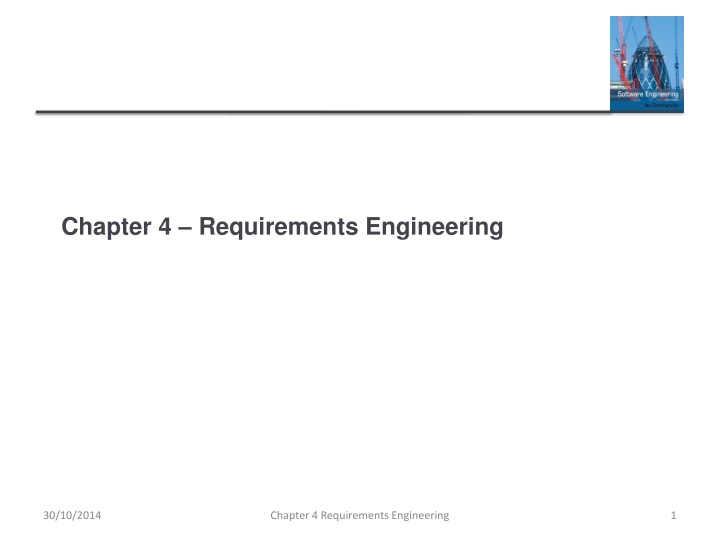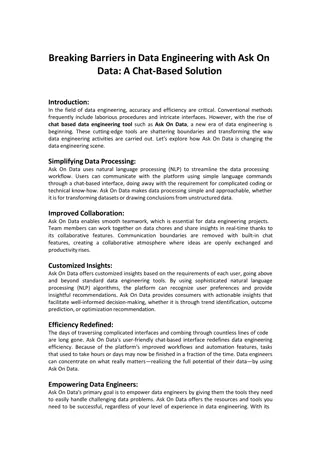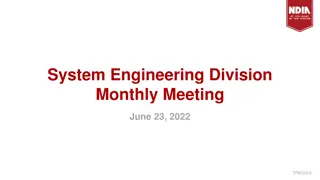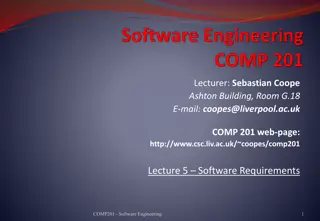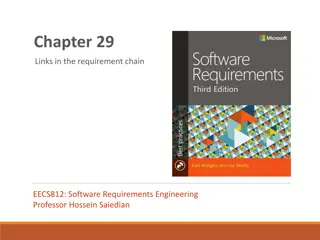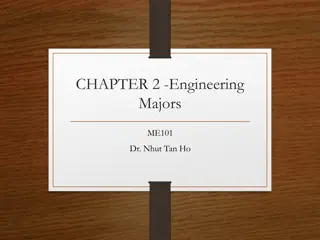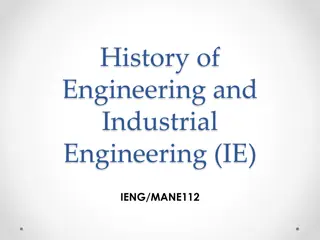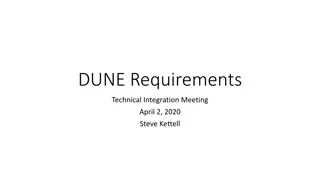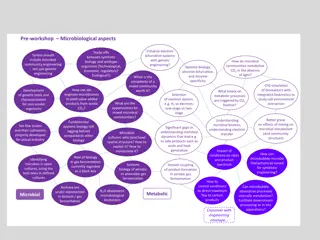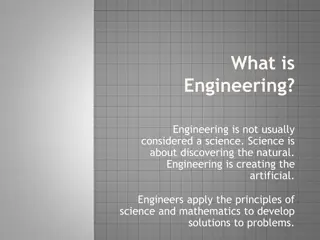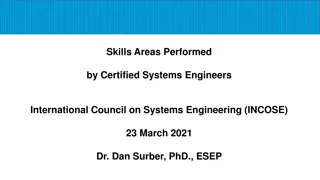Requirements Engineering Fundamentals
Requirements engineering involves defining the services a customer needs from a system and the constraints it must operate under. This process includes elicitation, specification, validation, and managing changes. Requirements range from abstract statements to detailed specifications, serving as the basis for contracts. Different types of requirements, such as user and system requirements, are essential for successful project development. Effective abstraction of requirements is crucial for allowing flexibility in selecting a contractor and ensuring alignment with the client's needs.
Download Presentation

Please find below an Image/Link to download the presentation.
The content on the website is provided AS IS for your information and personal use only. It may not be sold, licensed, or shared on other websites without obtaining consent from the author.If you encounter any issues during the download, it is possible that the publisher has removed the file from their server.
You are allowed to download the files provided on this website for personal or commercial use, subject to the condition that they are used lawfully. All files are the property of their respective owners.
The content on the website is provided AS IS for your information and personal use only. It may not be sold, licensed, or shared on other websites without obtaining consent from the author.
E N D
Presentation Transcript
Chapter 4 Requirements Engineering 30/10/2014 Chapter 4 Requirements Engineering 1
Topics covered Functional and non-functional requirements Requirements engineering processes Requirements elicitation Requirements specification Requirements validation Requirements change 30/10/2014 Chapter 4 Requirements Engineering 2
Requirements engineering The process of establishing the services that acustomer requires from a system and the constraints under which it operates and is developed. The system requirements are the descriptions of the system services and constraints that are generated during the requirements engineering process. 30/10/2014 Chapter 4 Requirements Engineering 3
What is a requirement? It may range from a high-level abstract statement of a service or of a system constraint to a detailed mathematical functional specification. This is inevitable as requirements may serve a dual function May be the basis for a bid for a contract - therefore must be open to interpretation; May be the basis for the contract itself - therefore must be defined in detail; Both these statements may be called requirements. 30/10/2014 Chapter 4 Requirements Engineering 4
Requirements abstraction (Davis) If a company wishes to let a contract for a large software development project, it must define its needs in a sufficiently abstract way that a solution is not pre-defined. The requirements must be written so that several contractors can bid for the contract, offering, perhaps, different ways of meeting the client organization s needs. Once a contract has been awarded, the contractor must write a system definition for the client in more detail so that the client understands and can validate what the software will do. Both of these documents may be called the requirements document for the system. 30/10/2014 Chapter 4 Requirements Engineering 5
Types of requirement User requirements Statements in natural language plus diagrams of the services the system provides and its operational constraints. Written for customers. System requirements A structured document setting out detailed descriptions of the system s functions, services and operational constraints. Defines what should be implemented so may be part of a contract between client and contractor. 30/10/2014 Chapter 4 Requirements Engineering 6
User and system requirements 30/10/2014 Chapter 4 Requirements Engineering 7
Readers of different types of requirements specification 30/10/2014 Chapter 4 Requirements Engineering 8
System stakeholders Any person or organization who is affected by the system in some way and so who has a legitimate interest Stakeholder types End users System managers System owners External stakeholders 30/10/2014 Chapter 4 Requirements Engineering 9
Stakeholders in the Mentcare system Patientswhose information is recorded in the system. Doctorswho are responsible for assessing and treating patients. Nurses who coordinate the consultations with doctors and administer some treatments. Medical receptionistswho manage patients appointments. IT staff who are responsible for installing and maintaining the system. 30/10/2014 Chapter 4 Requirements Engineering 10
Stakeholders in the Mentcare system A medical ethics manager who must ensure that the system meets current ethical guidelines for patient care. Health care managerswho obtain management information from the system. Medical records staffwho are responsible for ensuring that system information can be maintained and preserved, and that record keeping procedures have been properly implemented. 30/10/2014 Chapter 4 Requirements Engineering 11
Agile methods and requirements Many agile methods argue that producing detailed system requirements is a waste of time as requirements change so quickly. The requirements document is therefore always out of date. Agile methods usually use incremental requirements engineering and may express requirements as user stories (discussed in Chapter 3). This is practical for business systems but problematic for systems that require pre-delivery analysis (e.g. critical systems) or systems developed by several teams. 30/10/2014 Chapter 4 Requirements Engineering 12
Functional and non-functional requirements 30/10/2014 Chapter 4 Requirements Engineering 13
Functional and non-functional requirements Functional requirements Statements of services the system should provide, how the system should react to particular inputs and how the system should behave in particular situations. May state what the system should not do. Non-functional requirements Constraints on the services or functions offered by the system such as timing constraints, constraints on the development process, standards, etc. Often apply to the system as a whole rather than individual features or services. Domain requirements Constraints on the system from the domain of operation 30/10/2014 Chapter 4 Requirements Engineering 14
Functional requirements Describe functionality or system services. Depend on the type of software, expected users and the type of system where the software is used. Functional user requirements may be high-level statements of what the system should do. Functional system requirements should describe the system services in detail. 30/10/2014 Chapter 4 Requirements Engineering 15
Mentcare system: functional requirements A user shall be able to search the appointments lists for all clinics. The system shall generate each day, for each clinic, a list of patients who are expected to attend appointments that day. Each staff member using the system shall be uniquely identified by his or her 8-digit employee number. 30/10/2014 Chapter 4 Requirements Engineering 16
Requirements imprecision Problems arise when functional requirements are not precisely stated. Ambiguous requirements may be interpreted in different ways by developers and users. Consider the term search in requirement 1 User intention search for a patient name across all appointments in all clinics; Developer interpretation search for a patient name in an individual clinic. User chooses clinic then search. 30/10/2014 Chapter 4 Requirements Engineering 17
Requirements completeness and consistency In principle, requirements should be both complete and consistent. Complete They should include descriptions of all facilities required. Consistent There should be no conflicts or contradictions in the descriptions of the system facilities. In practice, because of system and environmental complexity, it is impossible to produce a complete and consistent requirements document. 30/10/2014 Chapter 4 Requirements Engineering 18
Non-functional requirements These define system properties and constraints e.g. reliability, response time and storage requirements. Constraints are I/O device capability, system representations, etc. Process requirements may also be specified mandating a particular IDE, programming language or development method. Non-functional requirements may be more critical than functional requirements. If these are not met, the system may be useless. 30/10/2014 Chapter 4 Requirements Engineering 19
Types of nonfunctional requirement 30/10/2014 Chapter 4 Requirements Engineering 20
Non-functional requirements implementation Non-functional requirements may affect the overall architecture of a system rather than the individual components. For example, to ensure that performance requirements are met, you may have to organize the system to minimize communications between components. A single non-functional requirement, such as a security requirement, may generate a number of related functional requirements that define system services that are required. It may also generate requirements that restrict existing requirements. 30/10/2014 Chapter 4 Requirements Engineering 21
Non-functional classifications Product requirements Requirements which specify that the delivered product must behave in a particular way e.g. execution speed, reliability, etc. Organisational requirements Requirements which are a consequence of organisational policies and procedures e.g. process standards used, implementation requirements, etc. External requirements Requirements which arise from factors which are external to the system and its development process e.g. interoperability requirements, legislative requirements, etc. 30/10/2014 Chapter 4 Requirements Engineering 22
Examples of nonfunctional requirements in the Mentcare system Product requirement The Mentcare system shall be available to all clinics during normal working hours (Mon Fri, 0830 17.30). Downtime within normal working hours shall not exceed five seconds in any one day. Organizational requirement Users of the Mentcare system shall authenticate themselves using their health authority identity card. External requirement The system shall implement patient privacy provisions as set out in HStan-03-2006-priv. 30/10/2014 Chapter 4 Requirements Engineering 23
Goals and requirements Non-functional requirements may be very difficult to state precisely and imprecise requirements may be difficult to verify. Goal A general intention of the user such as ease of use. Verifiable non-functional requirement A statement using some measure that can be objectively tested. Goals are helpful to developers as they convey the intentions of the system users. 30/10/2014 Chapter 4 Requirements Engineering 24
Usability requirements The system should be easy to use by medical staff and should be organized in such a way that user errors are minimized. (Goal) Medical staff shall be able to use all the system functions after four hours of training. After this training, the average number of errors made by experienced users shall not exceed two per hour of system use. (Testable non-functional requirement) 30/10/2014 Chapter 4 Requirements Engineering 25
Metrics for specifying nonfunctional requirements Property Speed Measure Processed transactions/second User/event response time Screen refresh time Mbytes Number of ROM chips Training time Number of help frames Mean time to failure Probability of unavailability Rate of failure occurrence Availability Time to restart after failure Percentage of events causing failure Probability of data corruption on failure Percentage of target dependent statements Number of target systems Size Ease of use Reliability Robustness Portability 30/10/2014 Chapter 4 Requirements Engineering 26
Requirements engineering processes 30/10/2014 Chapter 4 Requirements Engineering 27
Requirements engineering processes The processes used for RE vary widely depending on the application domain, the people involved and the organisation developing the requirements. However, there are a number of generic activities common to all processes Requirements elicitation; Requirements analysis; Requirements validation; Requirements management. In practice, RE is an iterative activity in which these processes are interleaved. 30/10/2014 Chapter 4 Requirements Engineering 28
A spiral view of the requirements engineering process 30/10/2014 Chapter 4 Requirements Engineering 29
Requirements elicitation 30/10/2014 Chapter 4 Requirements Engineering 30
Requirements elicitation and analysis Sometimes called requirements elicitation or requirements discovery. Involves technical staff working with customers to find out about the application domain, the services that the system should provide and the system s operational constraints. May involve end-users, managers, engineers involved in maintenance, domain experts, trade unions, etc. These are called stakeholders. 30/10/2014 Chapter 4 Requirements Engineering 31
Requirements elicitation 30/10/2014 Chapter 4 Requirements Engineering 32
Requirements elicitation Software engineers work with a range of system stakeholders to find out about the application domain, the services that the system should provide, the required system performance, hardware constraints, other systems, etc. Stages include: Requirements discovery, Requirements classification and organization, Requirements prioritization and negotiation, Requirements specification. 30/10/2014 Chapter 4 Requirements Engineering 33
Problems of requirements elicitation Stakeholders don t know what they really want. Stakeholders express requirements in their own terms. Different stakeholders may have conflicting requirements. Organisational and political factors may influence the system requirements. The requirements change during the analysis process. New stakeholders may emerge and the business environment may change. 30/10/2014 Chapter 4 Requirements Engineering 34
The requirements elicitation and analysis process 30/10/2014 Chapter 4 Requirements Engineering 35
Process activities Requirements discovery Interacting with stakeholders to discover their requirements. Domain requirements are also discovered at this stage. Requirements classification and organisation Groups related requirements and organises them into coherent clusters. Prioritisation and negotiation Prioritising requirements and resolving requirements conflicts. Requirements specification Requirements are documented and input into the next round of the spiral. 30/10/2014 Chapter 4 Requirements Engineering 36
Requirements discovery The process of gathering information about the required and existing systems and distilling the user and system requirements from this information. Interaction is with system stakeholders from managers to external regulators. Systems normally have a range of stakeholders. 30/10/2014 Chapter 4 Requirements Engineering 37
Interviewing Formal or informal interviews with stakeholders are part of most RE processes. Types of interview Closed interviews based on pre-determined list of questions Open interviews where various issues are explored with stakeholders. Effective interviewing Be open-minded, avoid pre-conceived ideas about the requirements and are willing to listen to stakeholders. Prompt the interviewee to get discussions going using a springboard question, a requirements proposal, or by working together on a prototype system. 30/10/2014 Chapter 4 Requirements Engineering 38
Interviews in practice Normally a mix of closed and open-ended interviewing. Interviews are good for getting an overall understanding of what stakeholders do and how they might interact with the system. Interviewers need to be open-minded without pre- conceived ideas of what the system should do You need to prompt the use to talk about the system by suggesting requirements rather than simply asking them what they want. 30/10/2014 Chapter 4 Requirements Engineering 39
Problems with interviews Application specialists may use language to describe their work that isn t easy for the requirements engineer to understand. Interviews are not good for understanding domain requirements Requirements engineers cannot understand specific domain terminology; Some domain knowledge is so familiar that people find it hard to articulate or think that it isn t worth articulating. 30/10/2014 Chapter 4 Requirements Engineering 40
Ethnography A social scientist spends a considerable time observing and analysing how people actually work. People do not have to explain or articulate their work. Social and organisational factors of importance may be observed. Ethnographic studies have shown that work is usually richer and more complex than suggested by simple system models. 30/10/2014 Chapter 4 Requirements Engineering 41
Scope of ethnography Requirements that are derived from the way that people actually work rather than the way I which process definitions suggest that they ought to work. Requirements that are derived from cooperation and awareness of other people s activities. Awareness of what other people are doing leads to changes in the ways in which we do things. Ethnography is effective for understanding existing processes but cannot identify new features that should be added to a system. 30/10/2014 Chapter 4 Requirements Engineering 42
Focused ethnography Developed in a project studying the air traffic control process Combines ethnography with prototyping Prototype development results in unanswered questions which focus the ethnographic analysis. The problem with ethnography is that it studies existing practices which may have some historical basis which is no longer relevant. 30/10/2014 Chapter 4 Requirements Engineering 43
Ethnography and prototyping for requirements analysis 30/10/2014 Chapter 4 Requirements Engineering 44
Stories and scenarios Scenarios and user stories are real-life examples of how a system can be used. Stories and scenarios are a description of how a system may be used for a particular task. Because they are based on a practical situation, stakeholders can relate to them and can comment on their situation with respect to the story. 30/10/2014 Chapter 4 Requirements Engineering 45
Photo sharing in the classroom (iLearn) Jack is a primary school teacher in Ullapool (a village in northern Scotland). He has decided that a class project should be focused around the fishing industry in the area, looking at the history, development and economic impact of fishing. As part of this, pupils are asked to gather and share reminiscences from relatives, use newspaper archives and collect old photographs related to fishing and fishing communities in the area. Pupils use an iLearn wiki to gather together fishing stories and SCRAN (a history resources site) to access newspaper archives and photographs. However, Jack also needs a photo sharing site as he wants pupils to take and comment on each others photos and to upload scans of old photographs that they may have in their families. Jack sends an email to a primary school teachers group, which he is a member of to see if anyone can recommend an appropriate system. Two teachers reply and both suggest that he uses KidsTakePics, a photo sharing site that allows teachers to check and moderate content. As KidsTakePics is not integrated with the iLearn authentication service, he sets up a teacher and a class account. He uses the iLearn setup service to add KidsTakePics to the services seen by the pupils in his class so that when they log in, they can immediately use the system to upload photos from their mobile devices and class computers. 30/10/2014 Chapter 4 Requirements Engineering 46
Scenarios A structured form of user story Scenarios should include A description of the starting situation; A description of the normal flow of events; A description of what can go wrong; Information about other concurrent activities; A description of the state when the scenario finishes. 30/10/2014 Chapter 4 Requirements Engineering 47
Uploading photos iLearn) Initial assumption: A user or a group of users have one or more digital photographs to be uploaded to the picture sharing site. These are saved on either a tablet or laptop computer. They have successfully logged on to KidsTakePics. Normal: The user chooses upload photos and they are prompted to select the photos to be uploaded on their computer and to select the project name under which the photos will be stored. They should also be given the option of inputting keywords that should be associated with each uploaded photo. Uploaded photos are named by creating a conjunction of the user name with the filename of the photo on the local computer. On completion of the upload, the system automatically sends an email to the project moderator asking them to check new content and generates an on-screen message to the user that this has been done. 30/10/2014 Chapter 4 Requirements Engineering 48
Uploading photos What can go wrong: No moderator is associated with the selected project. An email is automatically generated to the school administrator asking them to nominate a project moderator. Users should be informed that there could be a delay in making their photos visible. Photos with the same name have already been uploaded by the same user. The user should be asked if they wish to re-upload the photos with the same name, rename the photos or cancel the upload. If they chose to re-upload the photos, the originals are overwritten. If they chose to rename the photos, a new name is automatically generated by adding a number to the existing file name. Other activities: The moderator may be logged on to the system and may approve photos as they are uploaded. System state on completion: User is logged on. The selected photos have been uploaded and assigned a status awaiting moderation . Photos are visible to the moderator and to the user who uploaded them. 30/10/2014 Chapter 4 Requirements Engineering 49
Requirements specification 30/10/2014 Chapter 4 Requirements Engineering 50
